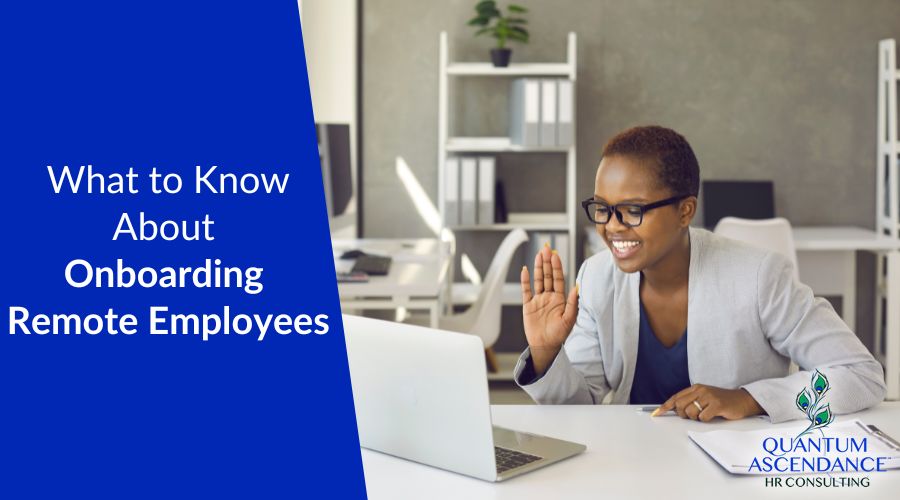
A lot has been said about the importance of employees making a great first impression.
But the truth is it’s just as important for employers to make a great first impression on employees, and much of that impression is formed during the onboarding process.
In my experience, a lot of companies’ onboarding processes tend to be fraught with issues and inadequacies, and this seems to be especially true when it comes to onboarding remote employees.
A survey from Paychex, which polled more than 1,000 working Americans, found that 70 percent of them believe the onboarding process can make or break a new hire’s experience, and nearly one-third feel that their onboarding experience was confusing.
What’s more, the survey discovered that 60 percent of remote workers feel disoriented by the onboarding process, and 52 percent feel devalued after onboarding.
In addition, it found that remote employees are more likely to feel undertrained than their on-site counterparts, and they’re also “117% more likely than on-site employees to plan to leave their employers soon.”
That being said, although it’s important to nail the onboarding process for all employees, as this survey shows, onboarding remote employees seems to be even more difficult to get right, and is saddled with its own unique set of challenges.
To be fair, for most employers, the idea of having remote employees was pretty far out until just a few years ago, so for a lot of businesses, this sort of thing might seem pretty new.
But while the pandemic might be over, working remotely is something that will likely never go away, so you can stop holding your breath.
As you can see from the graph below, a Federal Reserve Bank of Atlanta survey found that U.S. firms are expecting to see an increase in remote work over the next five years.

So, if you’re in the process of onboarding remote employees, and you’ve run into some issues, or want to learn about remote onboarding before you get started, then you’re going to want to keep reading.
In this article, I’m going to explain what you need to know about onboarding remote employees, so you can ensure you’re making the best possible impression.
The Importance of Making a Great First Impression When Onboarding Remote Employees

As I already mentioned, nailing the onboarding process is extremely important, no matter what kind of employee you’re hiring.
But for remote workers, this is even more important, as they face unique issues that can end up being exacerbated by a poor onboarding process.
With that in mind, here’s why it’s so important to get things right when onboarding remote employees:
Building Trust and Connection
Remote employees can feel isolated due to the lack of physical presence and face-to-face interaction they have to deal with.
That being said, a positive onboarding experience helps build trust and a sense of connection with the company itself and the rest of the team, regardless of where they might be working.
Moreover, remote employees who have a positive onboarding experience are more likely to feel engaged and motivated.
Overcoming Communication Barriers
Remote work relies heavily on digital communication, which can sometimes lead to misunderstandings or feelings of being disconnected or ignored.
But an effective onboarding process can help to ensure that clear communication channels and protocols are established, setting the stage for successful interactions in the future.
Cultural Integration
In a remote setting, it can be tough for new hires to absorb company culture from a distance, especially when many of them are already feeling so detached.
But a great onboarding process, which makes a positive first impression, can effectively convey your company’s values, work ethic, and culture, even for remote employees.
Reducing Turnover
A solid onboarding process for remote employees can significantly improve employee retention.
Because when remote employees feel supported, understood, and know that they’re part of the team from the start, they’ll be less likely to feel excluded or disillusioned, and more likely to stay.
Empowering Autonomy
Remote employees often work more independently, and this can be both a blessing and a curse.
But if you offer a great onboarding experience, you can empower remote workers with the necessary tools, information, and confidence to work autonomously and effectively.
Networking and Relationship Building
Since remote workers don’t have the same opportunities to organically build relationships as in-office employees, a well-planned onboarding process can facilitate networking and relationship building within the team and across the company.
Technology and Resource Familiarization
Onboarding is the perfect time to ensure remote employees are comfortable with the technology and resources they’re going to be using. A smooth introduction to these tools is essential for their long-term success and productivity.
Setting Employees Up for Success
Creating a great first impression when onboarding remote employees helps to lay a strong foundation for their future success, as it bridges the physical gap and fosters a sense of belonging and purpose.
What You Need to Know About Onboarding Remote Employees

Now that you know why it’s so important to make a great first impression when onboarding remote employees, let’s talk about what you need to know to make that impression.
Make Sure They Have All the Right Equipment
Making sure that remote employees have been provided with all the necessary equipment during onboarding is crucial for making a great first impression, so you should make sure to ship everything they need to them well ahead of their start date.
Providing the right equipment in a timely manner reflects your company’s professionalism and commitment to its staff, but keeping new hires waiting can create a very negative impression, as it makes you look like you’re either unreliable or just don’t care.
At the same time, if remote employees have everything they need to do their work right from day one, this impacts productivity by allowing them to perform tasks efficiently from the start, rather than waiting around to receive the equipment they need to do their job.
Ensure They Know What’s Expected of Them
When working remotely, the absence of any physical presence or direct supervision means employees must rely more on their own self-guidance and initiative.
That being said, when onboarding remote workers, it’s even more important to clearly define the expectations you have for them.
Ideally, this should outline their role, responsibilities, and the goals they should be aiming for, and you should also make them aware of the key performance indicators you’re expecting them to hit during their first week, first month, first year, and so on.
But if things are done haphazardly, and you’re not giving them any direction or specific targets to hit, this is when problems can arise, as this lack of clarity can lead to inefficiencies or errors.
What’s more, being aware of these benchmarks can help them to better assess their progress and identify areas for improvement, and having clear expectations can help to reduce the anxiety and overwhelm that new hires often feel, while boosting their confidence at the same time.
Don’t Forget to Give Them the Employee Handbook
Whether you’re dealing with in-office or remote employees, I cannot say enough about how important it is to have an employee handbook.
Providing new hires with an employee handbook can help you to create a great first impression, as it serves as a comprehensive guide to your company’s policies, procedures, culture, and expectations, reducing the time and effort new hires have to spend seeking basic information.
This can be particularly beneficial for minimizing the feeling of being overwhelmed that new employees tend to experience, especially when they’re working from home and may have a harder time getting a hold of you.
With that in mind, if you’ve got an employee handbook, that’s great, but you have to make sure that it includes all the policies and procedures that pertain to remote employees. If it doesn’t, update it or create a handbook specifically for your remote employees.
And if you don’t have an employee handbook, you should definitely get started on that or contact an HR professional to help you with it.
Establish Guidelines for Zoom Meetings
When building relationships with remote employees, using Zoom to speak with them face-to-face is absolutely essential.
Without these face-to-face interactions, it’s going to be very difficult to build a meaningful relationship with a remote employee, and this can lead to many issues.
With that in mind, you should establish guidelines for Zoom meetings, from the beginning of the onboarding process, so you can work to build that relationship right from the start and remote employees will know what to expect moving forward.
I would recommend ensuring that during all Zoom meetings, including those that take place throughout the onboarding process, everyone must have their camera on so they can properly interact and get to know each other, and everyone can feel like they’re an equal part of the team, whether they’re working at home or the office.
You should also encourage one-on-one meetings with managers, supervisors, and teammates during the onboarding process so remote employees and their in-office colleagues can get to know each other as much as possible before they start.
Make Sure to Collect All the Necessary Paperwork
This should go without saying, but the reality is this is where a lot of employers run into issues when onboarding remote employees.
Whether it’s a background check authorization, tax withholding form, employment eligibility verification, or something else entirely, these forms need to be properly filled out, signed, and collected.
But when you’re hiring someone via Zoom, you may end up dealing with problems related to this kind of paperwork.
For example, if you’re hiring remote employees, they won’t necessarily live in the same jurisdiction as you, and they may reside in a different state or even a different country, each of which will have its own legal requirements for employment.
What’s more, it can be quite difficult to remotely verify the authenticity of documents, including things like a candidate’s identity and the validity of their work eligibility.
In addition to all of this, the communication issues associated with remote hiring can easily lead to misunderstandings about things like what documents are needed, how they need to be filled out, and when and how they’re to be submitted.
All things considered, when onboarding a remote employee, make sure that you stay up to date on the relevant labor laws, tax regulations, and employment standards that apply to them, regardless of where they’re located.
Moreover, you should make sure to do everything you possibly can to verify the authenticity of the documents they provide. For example, you can use E-Verify to make sure you’re following the rules with I-9 documentation.
Also, make sure that you provide clear and detailed instructions regarding these employment documents, so you can avoid any misunderstandings.
Are you having issues with onboarding remote employees? Contact me today to find out how I can help.
Business Leadership, Team Management